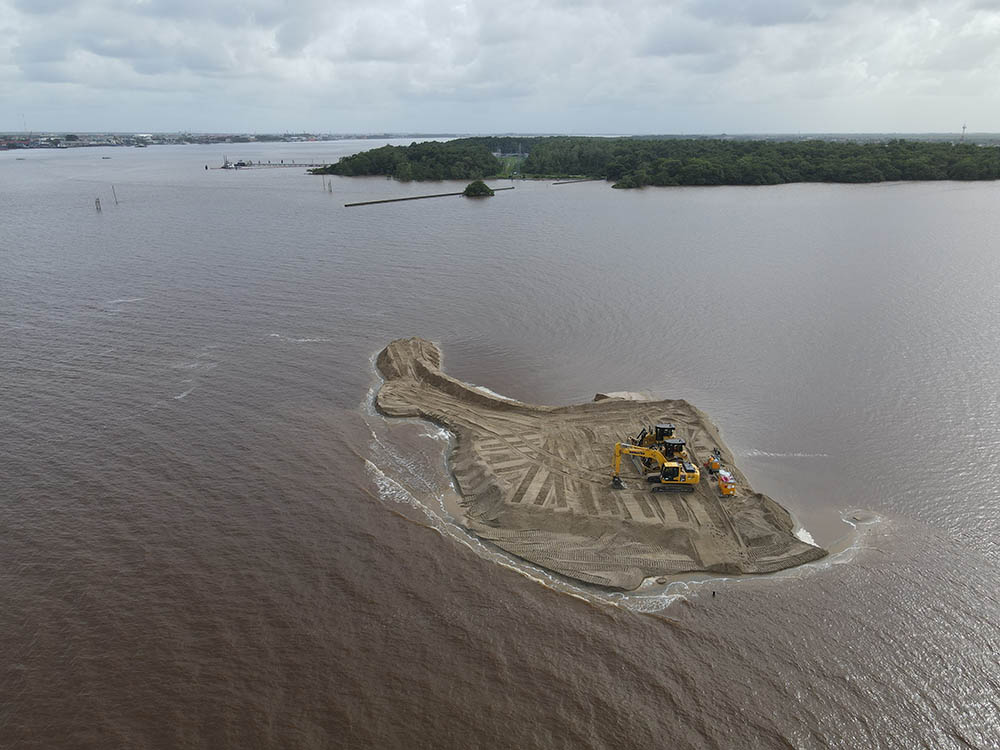The man-made island being created off of Vreed-en-Hoop for an oil and gas shore base is now visible.
Vreed-en-Hoop Shorebase Inc (VEHSI) in a press release said that the consortium managing the project has hailed this as a “momentous achievement and a first for Guyana”.
The island is part of the reclaimed land that will be transformed into the estimated 44-acre project to create the shore base facility. This facility will form part of the Port of Vreed-en-Hoop, West Coast Demerara.
A VEHSI release on Tuesday said that the project is currently in the sand key reclamation phase. During this phase, the dredger, M.V. Galileo Galilei, will continue the process of adding reclaimed material for the creation of the artificial island on which the new terminal will be situated.
The project will, in the first phase, add more than 44 acres to Guyana’s coastline. Phase one of the project is meant to be the special purpose vehicle to serve as a SURF (Subsea Umbilicals, Riser and Flowlines) Shorebase for projects of ExxonMobil’s subsidiary, Esso Exploration and Production Guyana Limited.
The release said that project managers have warned that the site remains an active construction zone and landing on the island is prohibited.
“The island structure, while visible, is not yet a fully stable formation. The team is therefore urging all to remain clear of the construction zone and to adhere to the previously issued notices. Construction is ongoing and the land mass will continue to be expanded”, the release stated.
The first part of the project in June entailed the dredging of the access channel in the Demerara River including the deepening/widening of the existing nautical channel, berth pockets, and turning basin. The release said that this phase has been hailed a success by the project managers and the upgraded channel has been handed over to the Maritime Administration Department (MARAD)
According to the release, VEHSI is currently the largest Guyanese private sector investment in the oil and gas sector and is expected to be worth over US$300 Million. The project is expected to become operational in 2023.
Vreed-en-Hoop Shorebase Inc. is a joint venture between NRG Holdings Inc.—a 100 percent Guyanese-owned consortium that is the majority shareholder – and Jan De Nul, an international maritime infrastructure company headquartered in Luxembourg.
Jan De Nul on December 20 invited proposals for the supply of two million metric tonnes of sand for the Vreed-en-Hoop Shore Base project.
“Jan De Nul Guyana Inc. invites bidders to submit proposals for the following: supply and delivery of two million (2,000,000) metric tons of sand to the Vreed-en-Hoop Shorebase at the Demerara River mouth,” the advertisement published in the Guyana Chronicle, stated.
Against the background that last month it had brought into the country a suction dredge that can pipe sand from the river bed, this newspaper asked, among other questions, if the shore base project would be using suction dredging for its land reclamation purposes.
“This advertisement is a request for proposals, it is to see what exists in the local market and options available to the project. A decision will be made based on the proposals received,” the company said through Perception Inc, the public relations agency representing the project.
The company says that bidders for the project will have to submit both a technical and commercial proposal.
The technical proposal must include particle size, mineralogy, density, and site of origin. Bidders must also supply their business registration or Articles of Incorporation, quarry licence, QHSSE Policy or safety records where applicable and their Guyana Revenue Authority and National Insurance Scheme compliances.
In the commercial aspect of the proposal, the price per metric tonne, inclusive of all taxes and royalties must be stated, with a price breakdown where possible.
In addition, the company makes clear that prices stated should be for sand placed on a barge/vessel at the Demerara River, excluding offloading costs. The bidders also have to state their earliest delivery date and capacity supply per week.










